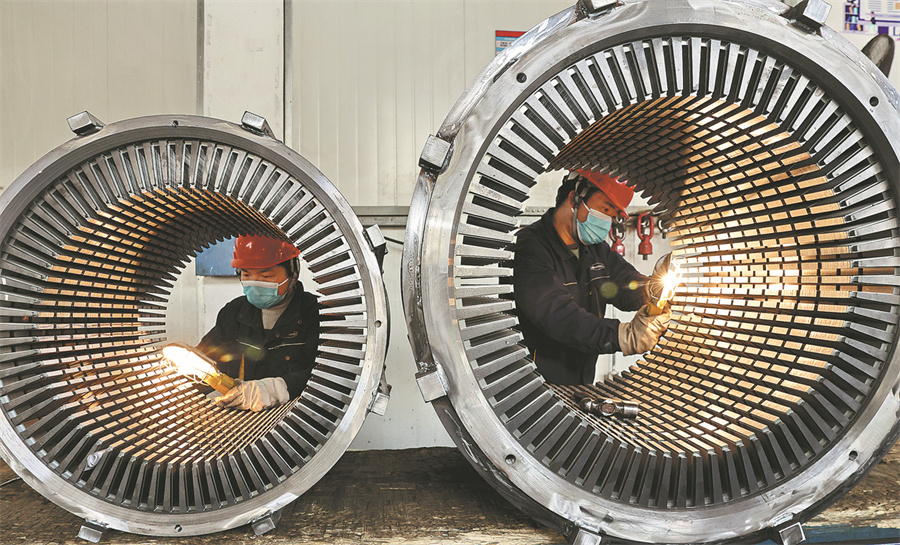Key region shows growth plan effective

Employees work on the production line of Tongda Silicon Steel Technology Co Ltd in Nantong, Jiangsu province. [Photo by Xu Congjun/for China Daily]
GDP figure of Beijing-Tianjin-Hebei highlights coordinated development
The combined GDP of the Beijing-Tianjin-Hebei region, a major economic zone in China, reached 10 trillion yuan ($1.46 trillion) in 2022, 1.8 times that of 2013, offering the latest proof of China's coordinated high-quality development at regional level, official data showed.
The GDP of both Beijing and Hebei exceeded 4 trillion yuan each in 2022, two times and 1.7 times that of 2013, respectively. Tianjin's GDP at 1.6 trillion yuan last year was 1.6 times that of 2013, the Beijing Municipal Bureau of Statistics said in a report on Monday.
Dong Xiaoyu, a senior expert at Zhongguancun Development Group, spoke highly of the coordinated development made by the region in terms of transportation, ecology and industries. He said the combined GDP of the Beijing-Tianjin-Hebei region accounted for around 9 percent of China's GDP.
Dong, who is also a researcher at the Capital Institute of Science and Technology Development Strategy, said China is on track to build a world-class city cluster in the region, steadfastly advancing regional economic integration.
This year marks the ninth anniversary of the implementation of the strategy for Beijing-Tianjin-Hebei coordinated development. During the past few years, the Beijing-Tianjin-Hebei region has witnessed rapid development in emerging sectors such as the digital economy and high-tech industries.
The value-added output of Beijing's digital economy was over 40 percent of the city's total GDP in 2022, 6.4 percentage points higher than that in 2015. While the industrial output of Tianjin's high-tech manufacturing sector and Hebei's high-tech industries accounted for 14.2 percent and 20.6 percent of the overall industrial output in the two regions in 2022, 1.9 percentage points and 8.8 percentage points higher than that in 2014 and 2013, respectively.
China is accelerating efforts to foster a new pattern of development that is focused on the domestic economy and features a positive interplay between domestic and international economic flows. The country is committed to developing a regional economic layout that complements each other's strengths and promotes high-quality development, experts said.
In recent years, the country has been actively speeding up the coordinated development of key regions, looking to boost connectivity and fuel more balanced development. Several major regional strategies have been unveiled over the years, including the Beijing-Tianjin-Hebei region, the Yangtze River Delta region and the Guangdong-Hong Kong-Macao Greater Bay Area.
Official data showed the Beijing-Tianjin-Hebei region, the Yangtze River Delta region and the nine cities in Guangdong province of the Guangdong-Hong Kong-Macao Greater Bay Area registered a combined GDP of around 49.5 trillion yuan last year, accounting for more than 40 percent of China's GDP.
Notably, the combined GDP of Shanghai, and the provinces of Jiangsu, Zhejiang and Anhui in the Yangtze River Delta region reached over 29 trillion yuan in 2022, or 24 percent of China's GDP.
Yang Jinghao, chief economist at Concat Data Technology (Hangzhou) Co, said the robust growth in the three major economic zones will not only promote a more balanced and coordinated development in the regions but also drive up the robust development of their surrounding areas, including Northeast China, western China, North China, the Yangtze River Economic Belt as well Southwest China.
Dong said the three major economic zones enjoy favorable conditions and advantages to build themselves into world-class clusters, which will strongly boost regional development, bridge the gap between China's northern and southern regions and stoke growth in central and western regions.
"Thus, the development of the three regions will help promote China's high-quality development, forming a key part of the Chinese path to modernization," he said.
























